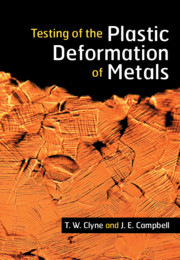Book contents
- Testing of the Plastic Deformation of Metals
- Reviews
- Testing of the Plastic Deformation of Metals
- Copyright page
- Contents
- Preface
- Nomenclature
- 1 General Introduction
- 2 Stresses, Strains and Elasticity
- 3 Continuum Plasticity
- 4 Mechanisms of Plastic Deformation in Metals
- 5 Tensile Testing
- 6 Compressive Testing
- 7 Hardness Testing
- 8 Indentation Plastometry
- 9 Nanoindentation and Micropillar Compression
- 10 Other Testing Geometries and Conditions
- Index
- References
5 - Tensile Testing
Published online by Cambridge University Press: 24 May 2021
- Testing of the Plastic Deformation of Metals
- Reviews
- Testing of the Plastic Deformation of Metals
- Copyright page
- Contents
- Preface
- Nomenclature
- 1 General Introduction
- 2 Stresses, Strains and Elasticity
- 3 Continuum Plasticity
- 4 Mechanisms of Plastic Deformation in Metals
- 5 Tensile Testing
- 6 Compressive Testing
- 7 Hardness Testing
- 8 Indentation Plastometry
- 9 Nanoindentation and Micropillar Compression
- 10 Other Testing Geometries and Conditions
- Index
- References
Summary
The uniaxial tensile test is the most commonly used mechanical testing procedure, and indeed it is in very widespread use. However, while it is simple in principle, there are several practical challenges, as well as a number of points to be noted when examining outcomes. For example, there is the issue of converting between nominal (“engineering”) and true values of the stress and strain. While many stress–strain curves are presented, and often interpreted, only as nominal data, it is the true relationship that accurately reflects the mechanical response of the sample. Furthermore, conversion between nominal and true values is straightforward only while the stress and strain fields within the gauge length of the sample are uniform. This uniformity is lost as soon as the sample starts to deform in an inhomogeneous way within the gauge length, which most commonly takes the form of “necking.” After the onset of necking, which may be quite difficult to detect and could occur at an early stage, useful interpretation of the stress–strain curve becomes difficult. However, FEM modeling does allow various insights into the behavior in this regime, with potential for revealing information (about the fracture event) that is otherwise inaccessible. There are also several important points relating to the way that the strain is measured during a test.
Keywords
Information
- Type
- Chapter
- Information
- Testing of the Plastic Deformation of Metals , pp. 81 - 106Publisher: Cambridge University PressPrint publication year: 2021
